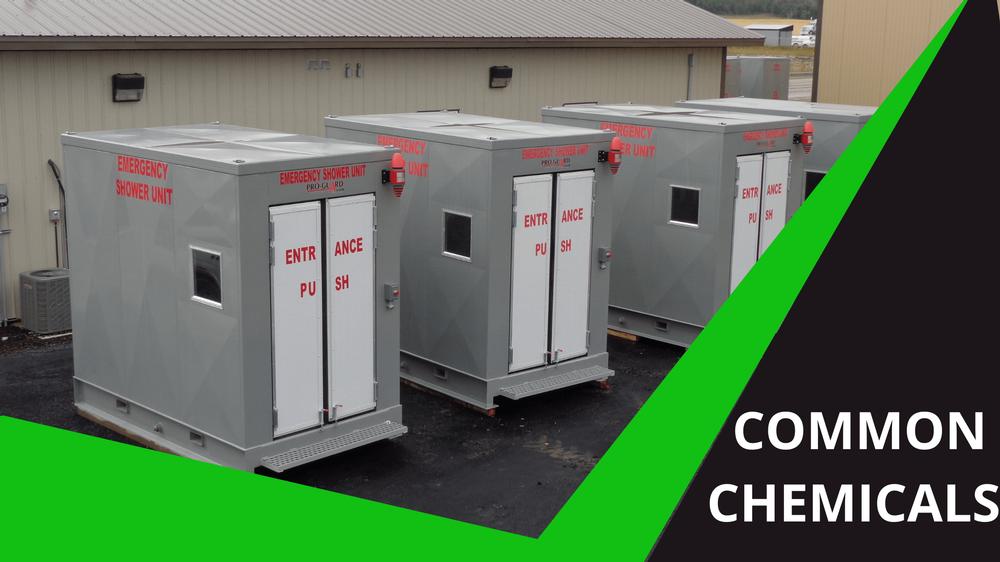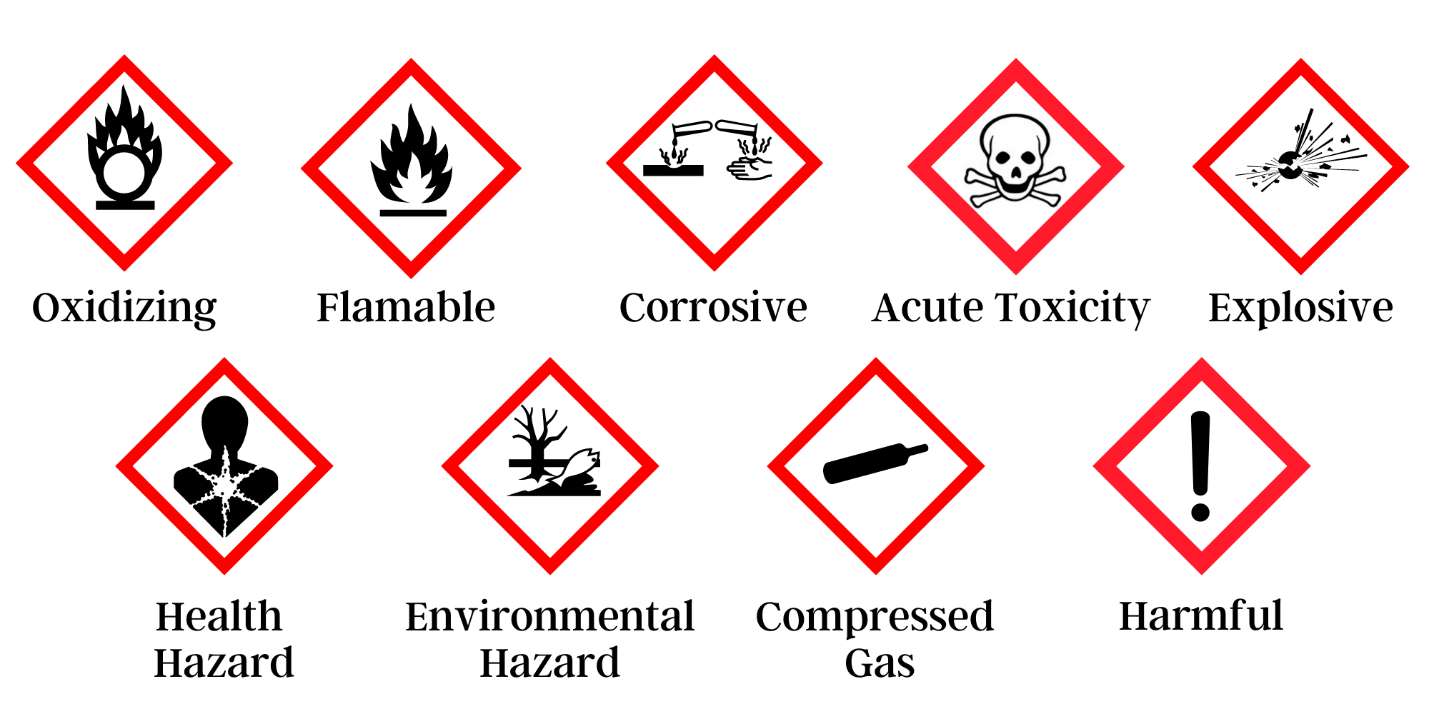Common Workplace Chemicals

Understanding the emergency protocol for each chemical that workers are exposed to in the workplace can help you better plan how to protect your employees. Finding the necessary information can be time consuming and overwhelming. We have created a break down of the most common chemicals related to injury, where to find the necessary information, and how to best protect workers from injury.
1. Common Chemicals
Workers can be exposed to harmful chemicals in almost every workplace, whether it be cleaning products or harsh separating solutions. A study done by the Canadian Occupational Safety Magazine found that 40% of common workplace chemicals will cause skin corrosion or irritation, and eye damage or eye irritation.
According to the Centre for Disease Control the following five chemicals are the top chemicals associated with workplace chemical injury.
| Name | Common Uses | Hazard | First Aid |
|---|---|---|---|
|
Ammonia |
Fertilizer.
Refrigerator gas.
In the manufacturing of plastics, textiles, and pesticides. |
Flammable gas.
May form explosive mixtures with air.
Contains gas under pressure; may explode if heated.
May displace oxygen and cause rapid suffocation.
Harmful if inhaled. Causes severe skin burns and eye damage.
Very toxic to aquatic life. |
Skin Contact: Take off immediately all contaminated clothing. Rinse skin with water/shower Wash contaminated clothing before reuse.
Eye Contact: Rinse cautiously with water for several minutes. Remove contact lenses, if present and easy to do. Continue rinsing.
Ingestion: rinse mouth immediately, do not induce vomiting.
Inhalation: Move person to fresh air and keep comfortable for breathing. |
|
Chlorine |
Disinfect water.
Bleaching agent for paper and cloth.
Found in cleaning products. |
May cause or intensify fire, oxidizer.
Contains gas under pressure; may explode if heated.
Causes severe skin burns and eye damage.
Fatal if inhaled.
Very toxic to aquatic life. |
Skin Contact: Take off immediately all contaminated clothing. Rinse skin with water/shower Wash contaminated clothing before reuse.
Eye Contact: Rinse cautiously with water for several minutes. Remove contact lenses, if present and easy to do. Continue rinsing.
Ingestion: rinse mouth immediately, do not induce vomiting.
Inhalation: Move person to fresh air and keep comfortable for breathing. |
|
Hydrochloric acid |
Production of chlorides, fertilizers, and dyes.
In electroplating, and in the photographic, textile, and rubber industries. |
Corrosive.
Causes severe skin, eye, and digestive tract burns.
Harmful if swallowed.
Mist or vapor extremely irritating to eyes and respiratory tract. |
Skin Contact: Take off immediately all contaminated clothing. Rinse skin with water/shower Wash contaminated clothing before reuse Get medical attention immediately.
Eye Contact: Rinse cautiously with water for several minutes. Remove contact lenses, if present and easy to do. Continue rinsing. Get medical attention immediately.
Inhalation: Remove to fresh air. If breathing is difficult, administer oxygen. Get medical attention immediately.
Ingestion: Do not induce vomiting. If vomiting occurs, keep head low so that vomit does not enter lungs. Get medical attention immediately. |
|
Sulfuric acid |
Cleaning of metals, removal of impurities from oil, manufacturing of chemicals. |
Corrosive to metals.
Skin Corrosion/Irritation.
Serious Eye Damage/Eye Irritation.
Specific target organ toxicity (single exposure).
Target Organs – Respiratory system. |
Skin (or hair) Contact: Take off immediately all contaminated clothing. Rinse skin with water/shower Wash contaminated clothing before reuse.
Eye Contact: Rinse cautiously with water for several minutes. Remove contact lenses, if present and easy to do. Continue rinsing.
Inhalation: Remove victim to fresh air and keep at rest in a position comfortable for breathing. |
|
Carbon Monoxide |
Manufacturing chemicals such as acids, esters, and alcohols.
Reducing mental ores. |
Extremely flammable gas. Contains gas under pressure; may explode if heated. Toxic if inhaled. Causes damage to organs through prolonged or repeated exposure. |
Eye Contact: Rinse cautiously with water for several minutes. Remove contact lenses, if present and easy to do. Continue rinsing. Skin (or hair) Contact: Take off immediately all contaminated clothing. Rinse skin with water/shower Wash contaminated clothing before reuse. Inhalation: Remove victim to fresh air and keep at rest in a position comfortable for breathing. |
2. Hazard Symbols
All chemicals should be labelled with what type of hazard they are. Knowing what each label means can help you quickly determine what action needs to be taken to reduce the severity of injury. Each chemical must be labeled with the appropriate image, these symbols will also be listed in the Material Safety Data Sheet for that chemical.

3. Safety Data Sheets
Safety Data Sheets (SDS) provide information on hazards and safety precautions about the product. The SDS provides more information about the product than what is found on the bottle. The information provided is what they are, how to use them safely, what to expect if recommendations are not followed, how to recognize symptoms of exposure, and what to do if emergencies occur.
Employers are required to have up to date SDS for all hazardous products that are kept in the workplace, the sheets should be provided by the supplier at the time of purchase or importation. SDS must be accessible to workers who have been exposed to the hazardous product and health and safety committee members at all times.
SDS must be updated when there is a change in information about how the product is classified, stored, handled, or how you protect yourself from it. Supplier are required to have accurate SDS at the time of the sale. Updated SDS can be found on your local government’s website.
Safety tips when handling chemicals
- Identify the chemicals being used.
- Keep a precise inventory pf all chemicals kept in the workplace.
- Know where the SDS’s are located.
- Ensure all chemicals are properly labelled with names, concentration, manufacturing date and information on the hazards.
For any inquiries about your safety shower needs please contact us at info@pro-guard.ca